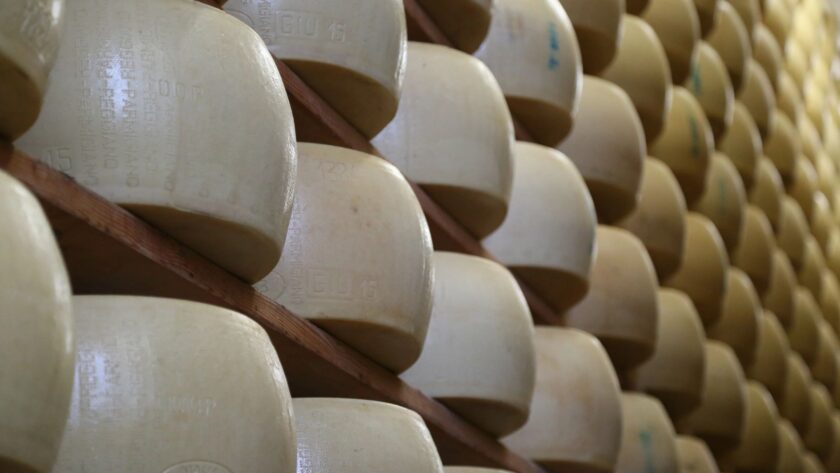Italian cuisine is renowned for its rich flavors and unparalleled use of high-quality ingredients, and when it comes to cheese, Italy’s hard varieties are in a class of their own. Parmigiano Reggiano, Pecorino Romano, and Grana Asiago are three of the most popular hard Italian cheeses, each bringing its own unique taste, texture, and history to the table. Whether you’re grating them over pasta, using them as a cheese course, or simply enjoying a sliver with a glass of wine, understanding the differences between these cheeses can elevate your culinary experience.
Parmigiano Reggiano: The King of Cheeses
What It Is:
Parmigiano Reggiano is often referred to as the “King of Cheeses,” and for good reason. Made exclusively in the regions of Parma, Reggio Emilia, Modena, and parts of Bologna and Mantua, Parmigiano Reggiano is a DOP (Denominazione di Origine Protetta) product, meaning its production is strictly controlled to ensure quality and authenticity.
How It’s Made:
This cheese is made from cow’s milk and aged for a minimum of 12 months, although it is often aged for 24, 36, or even longer. The longer it ages, the more complex its flavor becomes—developing nutty, umami-rich notes and a crumbly texture with crystallized salt pockets.
Flavor Profile:
Parmigiano Reggiano has a bold, savory flavor with hints of nuttiness and a slight fruity sweetness. As it ages, its texture becomes more granular, and its flavor intensifies. This cheese is perfect for grating over pasta, risotto, or soups, and it’s equally delicious enjoyed on its own with a drizzle of balsamic vinegar.
Why It’s Special:
What sets Parmigiano Reggiano apart is its strict production process. The cows that produce the milk must be fed a specific diet, and the cheese itself must meet stringent quality tests before earning the Parmigiano Reggiano stamp.
Pecorino Romano: The Saltier, Sheep’s Milk Alternative
What It Is:
Pecorino Romano is another DOP cheese but made from sheep’s milk rather than cow’s milk. Produced in the Lazio region (including Rome), Sardinia, and parts of Tuscany, Pecorino Romano has a history that stretches back to ancient Rome. In fact, it was a staple of the Roman soldier’s diet.
How It’s Made:
The cheese is aged for a minimum of five months, which allows it to develop its sharp, salty flavor. The aging process also gives it a firm, crumbly texture that is ideal for grating.
Flavor Profile:
Pecorino Romano is known for its sharp, briny, and tangy flavor, which is more pronounced than Parmigiano Reggiano. The sheep’s milk gives it a richer, more robust taste, with a saltiness that makes it ideal for dishes like Cacio e Pepe, where a strong, salty cheese is essential.
Why It’s Special:
What distinguishes Pecorino Romano from other hard cheeses is its high salt content, which is a byproduct of its traditional production methods. This saltiness makes it an excellent contrast to sweeter or more delicate dishes.

Grana Padano: The Versatile Cousin
What It Is:
Grana Padano is another cow’s milk cheese that shares similarities with Parmigiano Reggiano but is often considered a more accessible, less expensive alternative. Produced across northern Italy, including the Po Valley, Grana Padano is a DOP product as well.
How It’s Made:
Grana Padano is made from partially skimmed cow’s milk and aged for a minimum of 9 months. Like Parmigiano, it becomes more granular and develops deeper flavors as it ages. However, it is often considered slightly milder due to differences in production methods and the broader region in which it can be produced.
Flavor Profile:
Grana Padano has a slightly milder and sweeter flavor compared to Parmigiano Reggiano, with a less crumbly texture. It still boasts a nutty, savory taste with a touch of fruitiness, but its overall profile is smoother and less intense.
Why It’s Special:
Grana Padano is more affordable than Parmigiano Reggiano because its production region and processes are less restrictive. It’s a great all-purpose cheese for grating, snacking, or pairing with charcuterie and wine.
How to Use These Cheeses
- Parmigiano Reggiano: Best for finishing dishes like pasta, risotto, and soups. Its granular texture makes it ideal for grating over just about anything. It’s also fantastic on a cheese board, paired with figs, nuts, or a drizzle of honey.
- Pecorino Romano: Use when you need a salty punch of flavor, such as in classic Roman dishes like Cacio e Pepe, Carbonara, or Amatriciana. Its assertiveness pairs well with bold flavors like black pepper or garlic.
- Grana Padano: Perfect for everyday use in salads, pastas, or as a topping for vegetables. Its slightly milder flavor also makes it a good choice for melting into sauces or serving as part of a charcuterie board.
Aged to Perfection: The Importance of Time
A key difference between these cheeses lies in their aging. Parmigiano Reggiano and Grana Padano are aged for different lengths of time, which alters their textures and flavors. The longer the cheese ages, the more intense and crumbly it becomes.
- Parmigiano Reggiano: Typically aged between 12-36 months, with older varieties being more intense.
- Pecorino Romano: Aged for about 5-8 months, its shorter aging time makes it sharper and saltier.
- Grana Padano: Aged for 9-20 months, Grana Padano offers a balance between mildness and complexity.
Conclusion: Choosing the Right Cheese for Your Dish
When selecting a hard Italian cheese, consider the role the cheese will play in your dish. Do you want the deep, savory flavor of Parmigiano Reggiano? The salty sharpness of Pecorino Romano? Or the more versatile, mild sweetness of Grana Padano? Each of these cheeses brings something unique to the table, and understanding their differences will help you choose the right one for any recipe.
No matter which you choose, remember that these cheeses are not just toppings—they are ingredients that can transform a simple dish into something spectacular. Try using one, or all!, of these cheeses in this Cacio e Pepe recipe:



